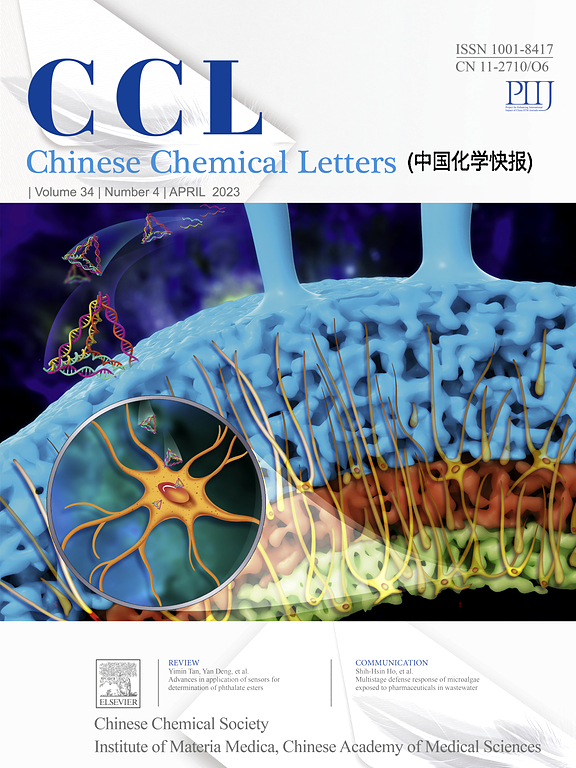Introducing high-valence element into P2-type layered cathode material for high-rate sodium-ion batteries
IF 8.9
1区 化学
Q1 CHEMISTRY, MULTIDISCIPLINARY
引用次数: 0
Abstract
P2-type layered transition-metal oxides with high energy density and rich variety have attracted extensive attention for sodium-ion batteries (SIBs) in grid-scale energy storage application, but they usually suffer from sluggish kinetics and large volume change upon cycling. Herein, we designed a high-performance P2-type Na0.67Ni0.31Mn0.67Mo0.02O2 (NNMMO) cathode with regulated electronic environment and Na+ zigzag ordering modulation via high-valence Mo6+ stabilization engineering. The achieved NNMMO cathode exhibits a high-rate capability with a reversible capacity of 77.2 mAh/g at 10 C and a long cycle life with a capacity retention of 75 % at 2 C after 1000 cycles. In addition, in situ X-ray diffraction and ex-situ X-ray absorption fine structure spectroscopy characterizations verify that the presence of Mo6+ also stabilizes the desodiated structure through a pinning effect, achieving an extremely low volume change of 1.04 % upon Na+ extraction. The quantified diffusional analysis and theoretical calculations demonstrate that the Mo6+-doping improves the Na+ diffusion kinetics, optimizes the energy band structure and enhances the TM-O bond strength. Additionally, the as-fabricated pouch cells by paring NNMMO cathode and hard carbon anode show impressive cycling stability with an energy density of 296.7 Wh/kg. This study broadens the perspective for high-valence metal ion doping to obtain superior cathode materials and pave the way for developing high-energy-density SIBs.

高倍率钠离子电池p2型层状正极材料中引入高价元
具有高能量密度、种类丰富的p2型层状过渡金属氧化物在钠离子电池(sib)电网储能应用中受到广泛关注,但其在循环过程中存在动力学缓慢、体积变化大的问题。在此,我们设计了一种高性能的p2型Na0.67Ni0.31Mn0.67Mo0.02O2 (NNMMO)阴极,该阴极具有可调节的电子环境和Na+之字形有序调制的高价Mo6+稳定化工程。所制备的NNMMO阴极在10℃下具有77.2 mAh/g的高倍率容量,在1000次循环后,在2℃下的容量保持率为75% %。此外,原位x射线衍射和非原位x射线吸收精细结构光谱表征验证了Mo6+的存在也通过钉钉效应稳定了脱核结构,在Na+萃取时实现了1.04 %的极低体积变化。定量扩散分析和理论计算表明,Mo6+的掺杂改善了Na+的扩散动力学,优化了能带结构,提高了TM-O键的强度。此外,通过NNMMO阴极和硬碳阳极的对偶制备的袋状电池具有良好的循环稳定性,能量密度为296.7 Wh/kg。本研究拓宽了高价金属离子掺杂获得优质正极材料的前景,为开发高能量密度sib铺平了道路。
本文章由计算机程序翻译,如有差异,请以英文原文为准。
求助全文
约1分钟内获得全文
求助全文
来源期刊

Chinese Chemical Letters
化学-化学综合
CiteScore
14.10
自引率
15.40%
发文量
8969
审稿时长
1.6 months
期刊介绍:
Chinese Chemical Letters (CCL) (ISSN 1001-8417) was founded in July 1990. The journal publishes preliminary accounts in the whole field of chemistry, including inorganic chemistry, organic chemistry, analytical chemistry, physical chemistry, polymer chemistry, applied chemistry, etc.Chinese Chemical Letters does not accept articles previously published or scheduled to be published. To verify originality, your article may be checked by the originality detection service CrossCheck.
 求助内容:
求助内容: 应助结果提醒方式:
应助结果提醒方式:


